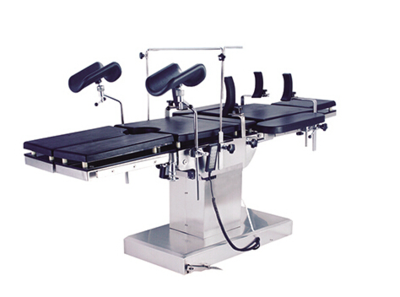Electric surgical bed is an important equipment in the operating room, and its technical requirements need to balance safety, functionality, and operational convenience. The following is an explanation from multiple key dimensions:
1、 Security technical requirements
1. Electrical safety
◦ It must comply with the safety standards for medical electrical equipment (such as IEC 60601 series), have anti leakage protection and ground fault monitoring functions, and avoid harm to patients and medical staff caused by current during surgery.
The circuit design should have overload protection to prevent the motor or control system from overheating, and the casing should use insulating materials to reduce the risk of electric shock.
2. Mechanical safety
The bed structure should be able to withstand a static load of at least 300kg, and the joints should be firmly connected to avoid tilting or collapsing during surgery.
The braking system must be reliable to ensure that the surgical table does not slide after positioning; At the same time, moving parts such as guide rails and lifting columns need to have anti pinch design to avoid injuring personnel during operation.
3. Electromagnetic compatibility
The electrical system of the electric operating table needs to have anti electromagnetic interference capability to avoid signal interference with other equipment in the operating room (such as monitors and high-frequency electric knives) and ensure the normal operation of the equipment.
2、 Functional technical requirements
1. Motion control performance
Multi dimensional adjustment: It is necessary to support vertical and horizontal movement, as well as electric adjustment of at least 8 degrees of freedom for lifting, tilting (such as head high and feet low, left leaning and right leaning), backboard/leg board bending, etc., to meet the needs of different surgical positions (such as general surgery, orthopedics, obstetrics and gynecology).
Accuracy and speed: The position adjustment accuracy should be ≤ 1mm, and the movement speed should be stable and controllable (such as lifting speed ≤ 30mm/s) to avoid discomfort or tissue damage to patients caused by rapid movement.
2. Intelligent control
· Equipped with touch screen or handle controller, support preset position storage (for example, at least five commonly used surgical positions are switched by one button), and reduce intraoperative adjustment time.
Some high-end products require wireless remote control function to facilitate medical staff to operate outside sterile areas and reduce the risk of infection.
3. Compatibility and Scalability
The bed surface needs to reserve standard interfaces (such as ISO standard fixture interfaces) to facilitate the installation of surgical accessories (such as headrests, arm supports, traction devices) and adapt to different surgical needs.
Support integration with operating room information systems (such as HIS, RIS) to achieve position data recording and traceability.
3、 Operation and comfort requirements
1. Human Machine Engineering Design
The bed surface material should be made of corrosion-resistant and easy to clean medical grade polymer materials (such as PU or stainless steel), with the ability to resist the corrosion of disinfectants such as iodine and alcohol. At the same time, the surface should be slip resistant to prevent patients from sliding during surgery.
Mattresses should have good cushioning performance, even pressure distribution, and reduce the risk of pressure ulcers caused by prolonged surgery.
2. Convenient operation
The control panel should be waterproof and dustproof, meet the protection level of IPX4 or above, and be easy to clean and disinfect during surgery.
The emergency stop button should be prominent and easily accessible, and in case of an emergency, all movements can be immediately interrupted to ensure safety.
4、 Environmental adaptability and maintenance requirements
1. Disinfection and sterilization
The surface of the bed should be able to withstand ultraviolet radiation, high-temperature steam (such as 134 ℃ sterilization), or chemical disinfectants (such as chlorine containing disinfectants) to ensure compliance with hospital infection control standards.
2. Maintenance and reliability
The motor and transmission system (such as gears and screws) need to have a long service life (such as continuous operation for 10000 times without failure), and be easy to maintain. Some components need to support quick replacement.
The equipment needs to be equipped with a fault self checking function, which can display abnormal codes through indicator lights or screens, making it easy for maintenance personnel to quickly locate the problem.
5、 Industry standards and certifications
Electric surgical tables must be certified by the National Medical Products Administration (NMPA) and comply with industry standards such as YY 0570 “Medical Electrical Equipment Part 2: Special Requirements for Operating Table Safety”. Export products must also meet international certification requirements such as CE and FDA to ensure that technical indicators and safety meet global standards.
In summary, the technical requirements of electric surgical beds revolve around the core of “safety, precision, and ease of use”. Through multidimensional technical design and standard specifications, they provide a stable and flexible operating platform for surgery, ensuring surgical efficiency and patient safety.
Post time: Jun-16-2025



